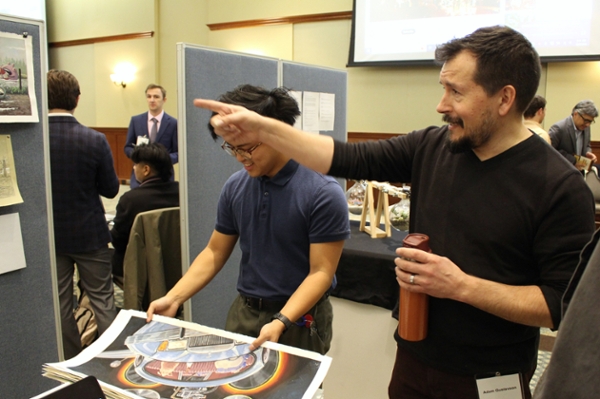Edelman CCCA celebrates student and faculty research with annual Showcase program
Edelman CCCA celebrates student and faculty research with annual Showcase program

Spanning a wide range of communication studies and practices, students and faculty in Rowan University’s Ric Edelman College of Communication & Creative Arts displayed dozens of projects during the college’s 4th annual Fall Research Showcase Dec. 6.
Representing virtually every field of study within the college, the program highlighted collaboration and innovation across departments and interests.
Jonathan Olshefski, a professor in the Department of Radio, Television & Film who recently released “Without Arrows,” his second feature-length documentary, said the vast range of projects presented had one thing in common: they were all based on solid research.
For his film, a story about a Lakota family on the Cheyenne River Sioux reservation in South Dakota, Olshefski shot intimate footage over 13 years.
“Like any researcher, you gather data,” Olshefski said. “In my case, the data is footage.”
Released this year, the award-winning film screened in Philadelphia in November and will premiere Jan. 13 on the PBS program INDEPENDENT LENS.
Among projects on display were reconstructions of prehistoric mammals used by students in the Biomedical Art & Visualization (BMAV) major. Junior Zoe Marino said she and other students, working from polyurethane models of saber toothed cat sculls, created intricate, free-hand pen and ink drawings.
“This is a good lesson because it makes us think in a different way,” Marino said. “We’re envisioning what the animal might have looked like.”
Adam Gustavson, a teaching professor in the Department of Art, displayed illustrations from his children’s book, “The Aliens Do NOT Want to Go Home,” which was published in June by Penguin Random House.
Gustavson said the storyline of the book, his second as author-illustrator, involves aliens who are actually children on their planet who are having such a good time on this one that they don’t want to leave.
“It’s a treatise on play,” Gustavson said.
Several students in Public Relations and Advertising researched various aspects and implications of rising social media use, including the role of anonymity on some platforms, the role of influencers on social movements, and the correlation between heavy social media use and depression.
Junior advertising major Ashleigh Sanes surveyed dozens of students regarding their social media use and their emotional wellness, and the results were not encouraging, she said.
“Some students spend 14 to 15 hours per day on social media,” she said. “And (many of them) don’t feel good about it. Some say they’re depressed.”
Sanes said social media like Facebook, Tik Tok and Instagram are ideal platforms for people to post about “living their best lives,” and that’s all users see. They do not see the difficulties that posters have in their own lives and, after watching hour after hour of such videos, users tend to look inward and compare their own lives with what they see on screen.
Though the platforms are addictive, she said, for the sake of their own mental health, avid users must learn to limit how much time they spend on social media and realize that, by and large, what they view is not real life.
“It’s a façade,” Sanes said. For peace of mind, “you have to live at your own pace, and don’t compare yourself to others.”



